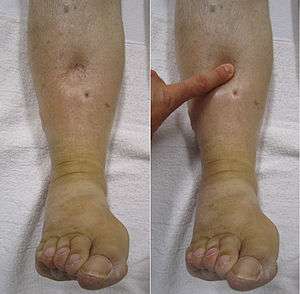Peripheral edema
Peripheral edema is edema (accumulation of fluid causing swelling) in tissues perfused by the peripheral vascular system, usually in the lower limbs. In the most dependent parts of the body (those hanging distally), it may be called dependent edema.
| Peripheral edema | |
|---|---|
| Other names | Peripheral oedema (alternative spelling), dependent edema |
 | |
| Leg edema | |
The condition is commonly associated with aging, but can be caused by many other conditions, including congestive heart failure, renal failure, liver cirrhosis, portal hypertension, trauma, alcoholism, altitude sickness, pregnancy, hypertension, sickle cell anemia, compromised lymphatic system, or merely long periods of time sitting or standing without moving.[1] Some medicines (e.g. amlodipine, pregabalin) may also cause or worsen the condition.[2]
Prognosis
Successful treatment depends on control of the underlying cause. Severe swelling can cause permanent damage to nerves, resulting in peripheral neuropathy. Many cases from temporary or minor causes resolve on their own, with no lasting damage.[2]
References
- Cho S, Atwood J (2002). "Peripheral edema". Am J Med. 113 (7): 580–6. doi:10.1016/S0002-9343(02)01322-0. PMID 12459405.
- "Lyrica – Pregabalin Capsule". Parke-Davis Division of Pfizer Incorporated. December 2016. Retrieved 24 April 2017.